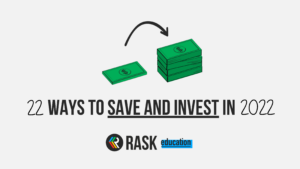Here is our 5-point share investing checklist to assist you with your investment research. This is a tool for people just starting out on their share investment journey and is not an exhaustive list.
PLEASE USE THE RASK PHILOSOPHY PAGE, RASK MEDIA & OUR FREE SHARE INVESTING COURSES TO HELP YOU LEARN.
OWEN’S HOT TIP: If you’re good with Google, you’ll be able to find 99% of this information online. You’ve just got to know what you’re looking for! Be sure to write down what you find. Do that, and you’re on your way to become your own investment analyst!
Share investing checklist overview
This checklist is a written version of an episode Kate & Owen recently shared on The Australian Finance Podcast.
We've also created a free PDF version for you to print out a stick on the fridge (if that floats your boat)!
#1 – What does the company do?
The businesses must be within our team’s circle of competence (i.e. what we can understand). Given our expertise lies in the technology, finance, software and industrial sectors, we almost never venture outside of these industries. Fortunately for us, the companies in these industries can be rewarding.
- Do I understand what the company actually does? (products, services, etc.)
- Who buys their products? (e.g. its target customers)
- Do I understand the company’s business model and how they make money?
- Have I researched the history and track record of the company?
#2 – Who runs the company?
Management must be aligned, talented, transparent, and consider themselves as ‘owner-operators’ (founders and families are great).
- Do I know who the CEO is, and have I looked into his/her track record and experience? Check LinkedIn!
- Do I know who is on the board of directors? Tip: read their bio and LinkedIn to find out if they have experience.
- What’s the salary of the CEO? (Use the Annual Report in Australia, and the “proxy statement” for US companies).
- Do the key people (CEO, board, etc.) own lots of shares in the company they run? (i.e. do they have ‘skin in the game’?)
- Is the CEO or senior management team the founder(s) of the company?
#3 – What is the company’s moat?
The companies must have a strong competitive advantage or ‘moat’. Competitive advantages include scale, network effect and brand.
- Do I know who the key competitors are? Think: the competing product providers (e.g. Microsoft Office competes with Google Docs).
- What makes this company different from its competitors? (e.g. Office is used in most workplaces, but Google is more of a start-up thing)
- Are there any key competitive advantages to this company? (Do people pay more for its brand, does it dominate the industry? Does it have patents or licences that protect its products?).
- Does this company have a diversified range of products/services and revenue streams?
- Is the business the top dog? Is the business a verb? Think ‘Google it’, ‘jump on a Zoom’, ‘did you Photoshop it?’.
#4 – Is the company in a growing industry?
The business must operate in a structurally growing and increasingly important sector, market or geography. The total addressable market (TAM) is very important when we are aiming to invest for 5-10 years or more.
- What is the total addressable market (TAM) for this company? Hint: search “[industry name] + market size”. You should be able to find free reports from Statista, Gartner, IBIS, etc.
- I’ve conducted a review of the industry, and here’s what I found…
- Do I believe this industry will grow over the next 10-20 years? (i.e. always make sure it’s not just a ‘concept’ or wishy-washy-BS ‘idea’ — are companies already making sales in this industry? If they’re not, the industry might not even exist yet!)
- Have I identified the key drivers of growth for this industry? (e.g. within cloud computing, the “public cloud” is growing fast; within ‘sustainable energy’ lithium batteries are winning etc.).
- Is the business going to be in a stronger position 10-20 years from now? Tip: unfortunately, at best this will be just a ‘good guess’ based on your research. Write down your reasons for and against.
#5 – What’s the company’s valuation?
The shares/business must be reasonably valued. We use the standard valuation modelling tools, such as discounted cash flow (DCF) analysis, internal rate of return (IRR), comparables and ratios, and sum-of-the-parts.
OWEN’S TIP: you can use Yahoo!Finance, your brokerage account and many other resources. If you want to be your own boss analyst, use the company’s annual report. Find the number of shares on issue (‘diluted shares on issue’) and then divide the profit and sales by that figure.
E.g. P/S ratio = total company sales for one year / number of shares. P/E = total company net profit / number of shares.
- Have I calculated the price-earnings ratio (P/E) ratio of the company? How does this compare to competitors/similar companies/the industry average?
- Have I calculated the price-to-sales ratio (P/S) ratio of the company? How does this compare to competitors/similar companies/the industry average?
Ready to analyse companies for real?
Now that you’ve made it through our share investing checklist, do you want to do a real valuation like Owen, Kevin, or Cathryn? Take the 100% FREE share investing valuation course. Watch Owen as he walks through the 6 most popular valuation models! Complete with downloads, pre-built spreadsheets, and more!
You can also tune into the Australian Investors Podcast, to learn more about share investing from the best in the game.



